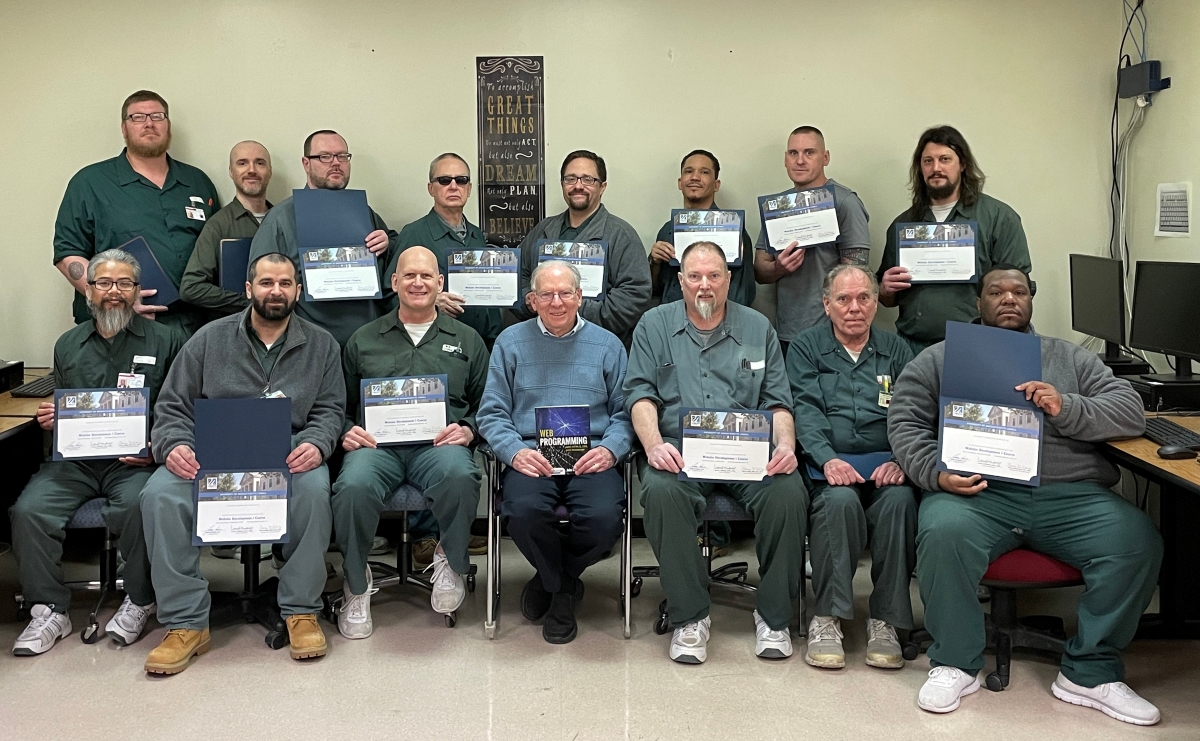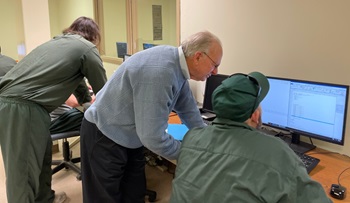A Lesson on Student Engagement: Retired Professor Teaches Incarcerated People HTML, CSS and JavaScript, Giving Them Purpose in the Process

Jesse Heines didn’t know he would be teaching “behind the wall.”
A professor emeritus of computer science at the University of Massachusetts Lowell with a half-century long track record of teaching, Heines just knew that when he retired in 2016 that he had to have a plan.
Heines also knew that this plan would have to involve volunteerism. Inspired by the work of Bryan Stevenson, social justice advocate and founder of the Equal Justice Initiative, which provides legal representation to people who have been illegally convicted, unfairly sentenced, or abused in state jails and prisons, Heines reached out to the New Hampshire Department of Corrections to offer his services in 2018. In his pursuit, Heines took particular inspiration from the Stevenson quote, “Each of us is more than the worst thing we’ve ever done.”
“They welcomed me with open arms,” he says.
At first, Heines wrote training programs for incarcerated men who worked in “the shops,” such as woodworking, metal working, and the like. Though not necessarily Heines’s disciplinary specialty, he worked on writing programs that led to apprenticeship (aka journeyman) certifications from the U.S. Department of Labor. He wrote six of these programs from 2018 through to when COVID-19 hit in early 2020, closing the prison system to volunteers such as Heines.
Once the pandemic started to subside in the summer of 2021, prisons around New Hampshire received computers by way of a grant. The New Hampshire Department of Corrections, flush with new hardware, lacked the in-house expertise to teach incarcerated individuals beyond the basics such as the Microsoft Office suite. The prison system didn’t need a back-office administrator. They needed a teacher.
“They wanted somebody who could actually teach programming! I said, ‘Well, I’ve done that for 30 years!’” Heines said.
Fast forward to today: Heines has been teaching inmates HTML, CSS and JavaScript—“behind the wall,” which is jargon for inside the prison—at the New Hampshire State Prison for Men in Concord, NH since April 2022. His course is 11-weeks long and consists of 22 classes. He teaches a class size of eight inmates per run of the course, which he has completed four times to date.
Heines learned quickly that there are challenges when teaching the incarcerated as compared to college students. For example, he says, the inmates can only use the computers at certain times—typically only the 160 total minutes allotted to his class during each week.
“It’s not like college where students have their own laptops,” he says. “College students leave your class, go to their dorms and do an assignment. In prison, the students can’t do that.”
Also, Heines was used to teaching web programming as a senior-level elective. His college students typically had extensive experience with programming. The men in Heines’s class at New Hampshire State Prison in some cases may have never touched a computer prior to working with him.
But what Heines has found through his work is that it doesn’t matter where the students of his class are in terms of their computer skills. In fact, Heines says, his course isn’t even about earning degrees, certificates or citations of any kind.
“I’m dealing with men who may not get out of prison for 30 years, I work with some who are lifers,” he says. “Many of the men work hard to fill their days with meaningful activities.”
Heines gives an example of an inmate he works with who does four different jobs in the prison just to keep busy and out of trouble. Heines sees his work as a way to give these men something to occupy their time and to give them purpose. It just happens to be through teaching computer languages.
“Wherever they are in their skills, I just try to advance them forward a bit. But that’s not what it’s about,” he says.
Heines uses Web Programming with HTML5, CSS, and JavaScript by John Dean for the coursework. This title is published by Jones & Bartlett Learning, which donated 10 copies to Heines for his course. Use of the physical textbook is helpful because the inmates can take the books back to their living units, a privilege not afforded when it comes to the institution’s computers. Though the book’s content is dense in detail, Heines lifts broad concepts from the text to help in his teaching and to better accommodate the inmates in their learning.
Heines is incredibly passionate about this work, but not necessarily from the standpoint of teaching inmates how to effectively apply programming languages. A compassionate and empathetic person, he is driven by something markedly different, and he cares deeply about his students.
“There’s no doubt these men have done something terribly wrong, they wouldn’t be in prison otherwise,” he says, his voice cracking a bit. “In a moment of passion, they did something. There are so many circumstances. You can’t put yourself in their shoes. Did they grow up with the support I grew up with? I had a mother and father who loved me, who believed greatly in education and gave me every advantage there was to have in my life. You just don’t know.”
Heines says this work has given him so much as well. His is an unpaid role, but it’s clear his work with the inmates of New Hampshire State Prison pays him back immeasurably.
“One man actually said to me, ‘If nothing else, it’s nice to be treated like a human being for an hour and 20 minutes twice a week,’” he says. “What do you do when someone says that to you, you know? You just say, ‘You’re welcome.’ What else can you say?”
His students, the prison system, and others in his orbit shower him with gratitude, which Heines says is plenty reward for his twice-weekly coding course at New Hampshire State Prison.
“I can’t solve the world’s problems, but what I can do is enrich a few people’s lives,” he says.
Read more:
- Cybersecurity Students Want Real-World Experience in the Classroom. Here’s How to Give It to Them.
- Instructors Provide Guidance on Teaching the Cybersecurity Workforce of the Future
- Top Trends for Cybersecurity Educators in 2023: Remote Strategies, AI-Augmentation and Broader Demographics
We were able to help Professor Heines, we can help you too! Visit the Jones & Bartlett Learning cybersecurity contact page or reach out to your Jones & Bartlett Learning representative to learn how we are standing by to support your needs.